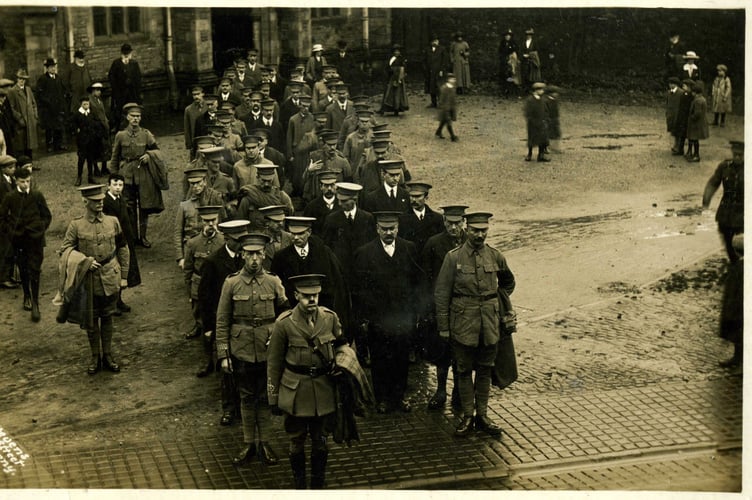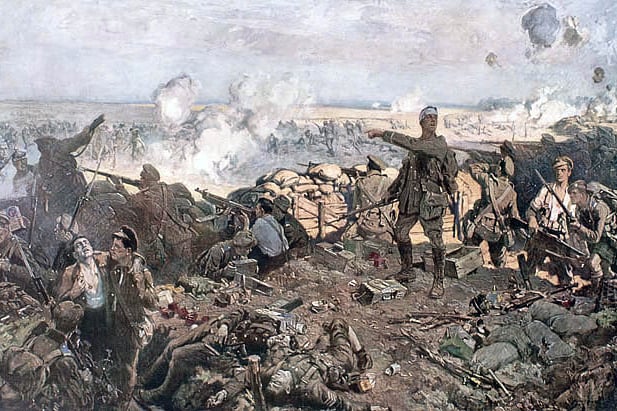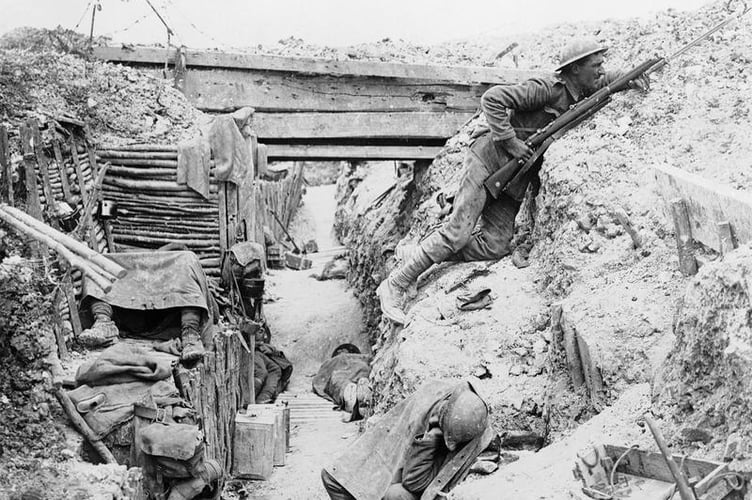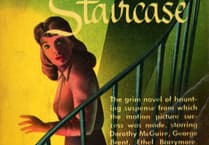EXACTLY 1020 officers and men of 3rd Battalion, The Monmouthshire Regiment, were cheered onto their troop trains at Abergavenny Station by families and friends at the outbreak of World War One. By the morning of May 10, 1915 only 134 officers and men were left standing after the mincing machine of the Battle of Ypres.
The 3rd Mons served with great distinction in France and Belgium during the 1st World War with the Regiment gaining 25 Battle Honours. On 8th May 1915 during the 2nd Battle of Ypres, the battalion made one of the most gallant stands in military history when in obeying the order to stand to the last man, the battalion was practically annihilated, without giving an inch of ground to the enemy.
The battalion lost 703 in killed and wounded and all but a handful of officers and men remained. The survivors were merged with those of 2nd Battalion, The Monmouthshire Regiment which had suffered a similar fate.
The 3rd Mons served in France for 18 months and were virtually wiped out twice, the second time, losing so many men at the Somme they were disbanded. But during that 18 months and despite horrendous casualties the 3rd Mons were in the thick of the fighting as a Pioneer Battalion which meant they took their share of defending the front line trenches but also were responsible for creating and repairing trenches and lines of communication battling German attacks, snipers and waist deep mud. In that short time, the ‘part time‘ soldiers from North Gwent established their place in the history of the First World War.
With war being declared, the Kings Proclamation mobilised the Territorial Force across Britain. In north Monmouthshire telegrams were sent to each company commander in Abertillery, Blaina, Cwm, Ebbw Vale, Sirhowy and Tredegar to mobilise their units and concentrate at their Headquarters in Abergavenny.
These young men of the Welsh Borders renewed the ancient spirit of their ancestors as they put on their khaki, probably with a sense of great adventure, who among them could predict what was to lie in wait for them across the Channel?
The assembly of the Battalion took place in the Market Hall, Abergavenny and that afternoon the Battalion Colours were handed into the custody of the Mayor and Corporation of Abergavenny for safekeeping. The next morning the Battalion mustered in Bailey Park, then marched to the railwaystation. No-one present could have known how long it would be before the Colours were restored to the Battalion or how many would never return from serving their country.
The first year of the war proved an anti-climax for the Monmouthshire men. After marching through Abergavenny accompanied by cheering crowds and bands, they climbed aboard two troop trains for Pembroke Dock, where they joined the Welsh Border Brigade, expecting to sail to France. Instead after four days under canvas they moved to Oswestry with the rest of the Border Brigade, the 1st and 2nd Monmouths and 1st Herefords.
By August 31st the whole Brigade was in Northamptonshire. In November after a fortnight digging trenches in East Anglia, the battalion was ordered to prepare for service in India. In November their Indian kit actually arrived, immediately followed by the cancellation of the original order. At the end of January the battalion was finally ordered to Flanders and sailed on the night of February 14th, 1915.

Frank Olding, in his meticulously researched “Hell Let Loose” 3rd Battalion, The Monmouthshire Regiment in World War 1 takes up the story.
"After a gruelling journey by train and forced march, the battalion reached billets at Steenworde. Here they were to stay for the next ten days for their final training in the techniques of trench warfare. A detachment of 40 men under 2nd Lieutenant GW Lancaster was sent to Ypres to join up with men from the 1st Monmouthshires to form a new unit - the 171st Tunnelling Company which first saw service at the infamous "Hill 60."
Meanwhile, having been transported to Bailleul in a fleet of 100 London omnibuses, the rest of the battalion was posted to the 83rd Brigade of the 28th Division.
On March 3-5th, each of the four companies was taken in turn into the front line for "twenty-four hours' instruction" in the care of regular troops. Private G Norton of A Company wrote home:
"The firing line is not as bad as you would think, at least it is not so bad as we expected it to be. The trenches we have been in are dry ones, and the only thing is the cold nights. We were shelled rather heavily last Tuesday; but our guns gave them something after. The men we were in with didn't seem to mind much. They say "Keep your napper down and you're alright!"
On the night of March 12th, 1915 the battalion was sent into the front line near a small village called Wulverghem about 5 miles south of Ypres. They were responsible for about 1000 yards of the trenches known as 10a and 10b alternating with the 5th King’s Own Royal Regiment. They stayed here for five days and were under heavy fire almost continually. Private AE Jones, of the Machine Gun Section (under Lieutenant Martin of the Hill) wrote home to Abergavenny:
"The Gun Section has been in the trenches. We went in last Friday [March 12th] week and came out on Wednesday night [March 17th] . . . We had two killed and eight wounded out of our battalion, so you can guess we had it a bit rough . . . The trench I was in had it the worst, I think, as they knew we had the machine gun there. I thought our number was up, as they shelled us for an hour and ten minutes. I don't think I want to go through the same thing again . . . We had a lot of snow here this week, and very cold."
The battalion continued its frontline service in this area until April 2nd when it was relieved by the 5th South Staffordshire Regiment and taken out of the line for a very brief period of rest.
Ypres
When the warring armies dug in during the winter of 1914-1915, the Allied lines developed a large bulge around the Belgian town of Ypres. This was the infamous "Ypres Salient" and the lay of the land meant that the British forces in this area were surrounded on three sides by the opposing German armies. It was here, on April 22nd 1915, that the Germans first used poison gas as the prelude to one of the most determined attacks of the war. The ensuing battle - later known as the Second Battle of Ypres - was to last almost a month and cost hundreds of thousands of lives on both sides.
On their arrival at Ypres on April 8th, the 3rd Mons had moved straight into the front line. They were to relieve French troops to the east of Polygon Wood and spent the next four days in the firing line. Private Reg Pritchard wrote home to his sister in the Mardy:
"It is much worse fighting where we are now to what it was in the last place. One of the chaps out of the same section as I am got wounded in the leg yesterday morning as we were leaving the trenches. One man got killed in our company by a trench mortar shell, he was in the same platoon as dad . . . I wonder how much longer this war will last, we have had sufficient fighting to go on with for a bit. I hope we are not out here next winter. I suppose it is very quiet on the Mardy now, nobody about like there used to be I suppose."

After a short stay in Ypres itself, the battalion found itself back in the front line on April 17th. Here they were to stay, without relief, for the next 17 days. On the afternoon of May 2nd, a shell landed among the machine gun section. Corporal Bosley, of Tredegar, wrote home to tell his parents of the death of his brother, Fred:
"I do not know how to write this letter, which is to convey such bad news and to give you all such a blow. Poor Fred was killed by a shrapnel bullet at about 4 p.m. on Sunday May 2nd. He died instantly. He and Lieutenant Martin were killed by the same shell. They buried them in an open space by a wood and I followed his last remains to the grave where the Colonel read the burial service. I cannot write anymore. He came to me about twelve o'clock. I wish I had kept him with me."
The gas attack of April 22nd had caused widespread panic among French troops and German forces swept through the gaps which opened up in the front line. On April 24th, D Company was sent to support the Canadian 7th British Columbia Battalion at St. Julien. The Canadian and British troops struggled to hold back the attack but, after suffering constant shelling and very high casualties, they were forced to retreat to a new defensive line. The 3rd Mons evacuated Polygon Wood on the night of May 2nd/3rd and reformed on the new line at Potijze. A Company (Captain Baker) and C Company (Captain Steel) moved up into support trenches. B Company (Captain Gattie) were stationed in the front line while D Company (Major Lewis) stayed in reserve at Potijze.
The evening of May 4th saw the beginning of a terrible German bombardment followed by a fresh attack. Casualties were horrendous and the front line troops soon became exhausted. The next morning (May 5th) Captain Steel led half of C Company up to reinforce the front line. They were caught by German machine gun fire and suffered terrible casualties. In civilian life, Captain Steel was a doctor and he set about attending the wounded as well as leading the advance. For this action, he was later awarded the Military Cross. One of the men in his company, Private AM Mitchell, wrote home to his parents in Abergavenny:
"Words utterly fail me to say what a hero Captain OWD Steel was during that fearful struggle. From every person I meet they tell me the same tale. Under very heavy shell and maxim fire he went out and fetched in wounded, bandaging them and if he doesn't deserve the V.C. no man on earth ought to get it . . . I would like you to let everyone in Abergavenny know what a brave officer he is."
An hour later, A Company (under Captain RA Lewis) also tried to reinforce the front line and again suffered terrible casualties. Private I Skidmore was awarded the Distinguished Conduct Medal for attending to the casualties until he was so badly wounded himself that he could not carry on. Private WB Barry wrote home to Abergavenny:
“I have been through it all right lately, I can tell you. The hottest work started on Wednesday, May 5th, when our Company went into the new trenches after we retired from our old position. The Germans started to shell us at 4 o’clock in the morning, and did not stop until 8 o’clock at night, so you can see we had sixteen hours of it. It was awful. Talk about hell let loose; it was worse than that.”
May 6th was a "quieter" day. Shelling was less severe and there was no German attack. The heavy shelling returned on May 7th and casualties began to rise again.
On the morning of May 8th, the battalion had three companies (A, D and B) in the front line and one (C Company) in support. Half a mile to the north, the 1st Monmouths were fighting with the 83rd Brigade. The German bombardment began at 5.30 am followed by the first infantry attack at 8.30. This was driven off. Almost immediately, the shelling started again and, at 9.00 am, the Germans attacked again and were again driven back. This was to be the pattern throughout the day.
After another hour of shelling, the front line was virtually destroyed and there were few survivors from A and D Companies. Those that were left were wiped out by machine gun fire trying to evacuate the front line trenches. Of the 500 men in A and D Companies only 29 were left. Private Rees Jones described the withdrawal in a letter home to Abergavenny:
“A good many of our men were lying killed or wounded in the trenches to the right and left of where I was. I was shot in the face by a rifle bullet about 11 o’clock, when the word was passed up ‘All for yourselves’. We then commenced to retire . . . I took shelter in a hole made by a Jack Johnson shell and on looking out I saw Capt. Baker lying on the ground a few yards away. He had been shot, I think, in the hip or the lower part of the body and was quite unable to rise. I went to his assistance and dragged him about seven yards nearer the hole, when he told me to look after myself . . . When I left Capt. Baker, the Germans were only about 600 yards away and were coming on swiftly, firing all the time.”
The survivors of C Company were forced back to the battalion headquarters where they regrouped. The battalion commander, Lieutenant Colonel Gough, led them in a counter attack on Frezenberg. They held their new position until 11.00 am when they were ordered to withdraw. Ironically, they found themselves back at Potijze – the very place they had started out from on May 3rd. At 2.30 pm and again at 3.30, the 3rd Mons joined a counter attack on Verlorenhoek. This eventually ground to a halt at 5.30 pm. The battalion was finally withdrawn from the firing line and marched to billets in Vlamertinghe. Private Badham, of Abergavenny, wrote to a friend in the military hospital in Leeds:
"The 8th was the day I shall never forget. They started bombarding the same time in the morning, and about half an hour afterwards we could hear a long blast of a whistle, and the attack started. We were only a handful of men, and they came on in thousands, but we kept them at bay; but I knew we would have to give way before long. The fellows on our left and right were retiring and we had orders to do the same, but we did not go until we put some more shots into them. It was in the retirement that we lost a lot of men. They were bayoneting our wounded that we had to leave behind."
Throughout the battle, B Company (under Captain Gattie) were separated from the rest of the battalion. They were in the front line in a wood near Red Lodge. They were shelled heavily all day throughout May 5th, 6th and 7th. Strangely, the battalion history records that:
"The nights were absolutely quiet, and it was safe to walk about in the open behind the front line. Rations and letters came up regularly and one fortunate officer even received a tin of cooked sausages!"
On the morning of May 8th, the wood came under heavy shelling and Lieutenant Groves and Lieutenant Palmer were killed by a direct hit on their dug-out. After two German attacks on the King's Own Yorkshire Light Infantry in the front trenches, B Company charged across open ground to reinforce them and Captain Gardner was shot dead. The company stayed in the front trench all day and eventually became cut off.
Casualties were high and the soldiers were coming under fire from their own troops behind them. Under cover of darkness, the remnants of the company began to withdraw to re-join the rest of the battalion. Just as they got back to the line at dawn on May 9th, a staff officer ordered them back into the front line. They were finally withdrawn on the morning of May 10th and marched back to Vlamertinghe where they re-joined what was left of the rest of the battalion. The condition of the men is tellingly summed up in a letter from Captain O. W. D. Steel to the father of Lieutenant Palmer:
“Possibly news has reached you of the events of May 6th till May 9th. I hope I may never have to live through such days again. We are all more or less shattered, of course, and it is sheer agony to recall that black Saturday, when your son met his death. I think we have all got beyond the stage of sensation and are become numb and dulled. So many officers and men have been killed or wounded that the mind is incapable of comprehending it. For this we must be thankful, otherwise I fully believe we should become insane.”
In writing the history of the 3rd Mons in World War 1, I have really only collated the stories and archives that have gone before. Frank Olding’s “Hell Let Loose” 3rd Battalion, The Monmouthshire Regiment in World War 1 produced for Abergavenny Local History Society in 2015, archives of the Regimental Museum of The Royal Welsh, Brecon and Abergavenny Museum tell the story with accuracy and compassion, a fitting tribute to the men of North Monmouthshire who cheerfully marched off to war, and so many never came back.
See next weeks Chronicle for the next instalment in the history of the 3rd Mons and World War One.





Comments
This article has no comments yet. Be the first to leave a comment.